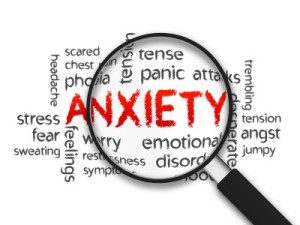Four Steps to Fix Anxiety
If you suffer from anxiety then you are likely looking for an easy way to fix it. Let me tell you right now, there is no easy fix, or magic pill to cure your anxiety. It takes time to fix. It also needs help from within. Only you can calm your anxiety. Other people can give you advise and guidance but it is your mind and the healing needs to be done by you using your willpower and logical thinking and a little bit of bravery.
Here are the four R’s you need to follow to overcome your anxiety:
- Research
- Relaxation
- Reprogram
- Exposure……Ok, three R’s and an E!
Step 1 – Research Anxiety
 You can’t do anything until you know whats going on. You need to know what anxiety is and why you are feeling the way you do. This step is easy and you can find all the info you need right here on the anxietyfoundation.com….But obviously feel free to scour the internet. There are lots of good sources of info about anxiety.
You can’t do anything until you know whats going on. You need to know what anxiety is and why you are feeling the way you do. This step is easy and you can find all the info you need right here on the anxietyfoundation.com….But obviously feel free to scour the internet. There are lots of good sources of info about anxiety.
Once you know what anxiety is and why you feel this way you can start to understand how you are going to beat it. Remember, anxiety doesn’t make you abnormal. Anxiety is an important thing. It helps us avoid danger and guide us safely through life.
An anxiety disorder on the other hand is where your anxiety has got out of control. If your anxiety is stopping you from living a normal life then you need to do something. The first step is researching.
Step 2 – Learn to Relax
Relaxation isn’t something that comes easily to some people. And in fact most of us struggle to relax at times. Breathing exercises and muscle tensing are two methods you can use to relax.
Breathing is something every person on the planet does. B ut you can use breathing techniques to relax you. Fast breathing is associated with anxiety. The faster you breath the dizzier you get and the faster you breath as you start to panic. To use breathing to relax you can use a technique called ‘in and pause’ (I have no idea if its called that, I just made it up!). Start by sitting comfortably and take a deep breath in through your nose, hold the breath in for 2 seconds and then slowly breath it out through your mouth. Wait for 2 seconds then breath in through your nose again….Keep this technique going for a couple minutes a day and you will notice a calmer you.
ut you can use breathing techniques to relax you. Fast breathing is associated with anxiety. The faster you breath the dizzier you get and the faster you breath as you start to panic. To use breathing to relax you can use a technique called ‘in and pause’ (I have no idea if its called that, I just made it up!). Start by sitting comfortably and take a deep breath in through your nose, hold the breath in for 2 seconds and then slowly breath it out through your mouth. Wait for 2 seconds then breath in through your nose again….Keep this technique going for a couple minutes a day and you will notice a calmer you.
Muscle control is another technique that can help you relax and help calm your anxiety. This technique involves tensing your muscles and relaxing them.
The idea is to recognize that you are stressed by tensing muscles throughout your body and releasing them. You will learn to spot when you are tense by identifying what it feels like to release the tension in the muscles.
You should start by sitting comfortably. Take a few deep breaths using the breathing exercise above. Then tense one of your muscles. This could be your leg muscles or your arm muscles or your neck and shoulder muscles. It doesn’t matter which ones you tense as long as you follow the same technique. Tense the muscles up and hold them tensed for 5 seconds. Then relax them completely, staying relaxed for 10 seconds then repeat. You can work your way through the different muscles in your body repeating this technique.
Step 3 – Reprogram
Relaxation and learning is essential in your recovery but it will only take you so far. At some point you need to address what is causing your anxiety and fix it.
Your anxiety is being caused by worrying thoughts. Unfounded worrying thoughts. The idea of of this step is to replace the unfounded worrying thoughts with a more rational way of thinking. To convince your brain that there is no need to worry. It involves convincing you to stop focusing on the bad and start focusing on the good.
You need to identify exactly what your worrying thoughts are and then challenge them. The world is often not the dangerous place that your brain would have you think and it is possible to see the world as a non-threatening place once again.
Now this i an important step so it may take a little time
The first thing to do is to listen to your inner voice. What is it saying to you in situations of anxiety? Everybody thinks differently and the way we think effects how we react to certain situations. For example you are walking down the street and you see a stranger approaching. Some people see the stranger and think nothing of it, walk past and remain feeling calm. Another person might see the stranger and wonder if they are judging them, looking at them, about to mug them; They cross the road to avoid the stranger and feel extremely anxious. Feelings of anxiety are often a mystery to you unless you examine your thoughts at the moments the anxiety starts and is happening.
Pay attention to what your inner self is saying.
Once you are starting to pay attention to what you are thinking you can start to identify which thoughts are causing your anxiety and why. You need to identify what is making you anxious and what bad things you are expecting to happen.You can usually do this by asking yourself what you are worried will happen.
Once you have started to identify the thoughts that are causing you anxiety and what you are expecting to happen you can start to challenge your thoughts.
Your thoughts are just the way you see things in the world. And just like learning something new about the world, you can change your way of thinking and thus change your reaction to situations, calming your anxiety and giving you a less stressful view of everyday situations.
It sounds easy but challenging your own thoughts is extremely difficult to do. The first thing to realize is that our thoughts are just a guess about situations, they often aren’t based on solid fact.
To challenge your thoughts you need to query what you are thinking.
Is it just a guess that something bad is going to happen? If there is no solid evidence then the chances are that the thought is complete nonsense and you can try and ignore it. Has it ever happened before? What would your friends think about your thoughts? Whats the worse that could happen?
Reprogramming yourself is all about identifying your thought patterns during your anxiety and then challenging them by using reason and questions. Its surprising how powerful this is and how quickly you can thinking realistically rather than pessimistically.
Step 4 – Expose Yourself to Anxious Situations
This is a brave step and requires somewhat of a leap of faith. You need to expose yourself to the very situations that are causing you anxiety. The theory is that by increasing exposure to anxiety causing situations your mind realizes that nothing bad is actually going to happen in these situations.
Start by writing a list of situations that make cause you anxiety and then rate them an a scale of one to ten.
Start with the least anxiety causing situation. Now you need to go and put yourself in that situation every day, or as often as you can until you no longer feel anxious in the situation. Eventually you wont feel anxious anymore in that particular situation.
You need to work your way through the list until you have ticked them all off. This may take some time and you could combine it with step 3 if you like.
There you have it, four steps to cure anxiety….I know its tough but you can get there, you just need to keep pushing and trying and you can overcome anxiety.
